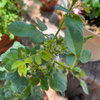I ran across some studies about extra calcium in rose tissues strongly reducing botrytis petal blight in cut roses and increasing vase life by 37%, more than any other preparation including the silver compound in commercial vase-life products. The calcium is delivered by spraying plants with calcium sulfate (gypsum) one day before cutting roses at the split-sepal stage or by soaking stems for 15 hours in solution after cutting.
The amounts used were 50 mM calcium sulfate solution for the soak-- is that about 2 TSP/quart?-- and 10-20 mM for the spray-- is that about 1 TB/gallon? (Don't trust these numbers!)
It sounds like spraying with gypsum might reduce botrytis in the garden and would be worthwhile adding to vase water. Apparently it works by strengthening cell walls and reducing the production of ethylene gas.
In sprays, the presence of K, Mg, and Na ions reduced the absorption of Ca by foliage (don't combine with foliar ferilizer).
http://www.scielo.br/scielo.php?pid=S0100-41582003000400006&script=sci_arttext&tlng=en










roseleaf
berndoodle
Related Professionals
Maple Valley Landscape Architects & Landscape Designers · Beachwood Landscape Architects & Landscape Designers · Cottonwood Landscape Architects & Landscape Designers · Gainesville Landscape Contractors · Peabody Landscape Contractors · Brookside Landscape Contractors · Bridgeview Landscape Contractors · Cupertino Landscape Contractors · Fairview Landscape Contractors · Golden Landscape Contractors · Hannibal Landscape Contractors · Lake Worth Landscape Contractors · North Canton Landscape Contractors · San Carlos Park Landscape Contractors · Snoqualmie Landscape ContractorsmichaelgOriginal Author
mike_rivers
roseleaf
michaelgOriginal Author
michaelgOriginal Author
ceterum
roseleaf
mike_rivers
mike_rivers
roseleaf
mike_rivers
ceterum
michaelgOriginal Author
roseleaf
ceterum
michaelgOriginal Author
roseleaf
mike_rivers
michaelgOriginal Author
roseleaf
michaelgOriginal Author
roseleaf
michaelgOriginal Author
ceterum
michaelgOriginal Author
flower2sew
roseleaf
mike_rivers
ceterum
michaelgOriginal Author
ceterum
michaelgOriginal Author
ceterum
michaelgOriginal Author
michaelgOriginal Author
ceterum
michaelgOriginal Author
luxrosa
michaelgOriginal Author
michaelgOriginal Author
ceterum
michaelgOriginal Author
michaelgOriginal Author
mike_rivers
michaelgOriginal Author
mike_rivers
michaelgOriginal Author
michaelgOriginal Author